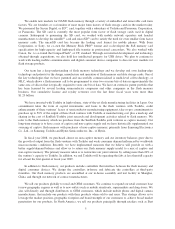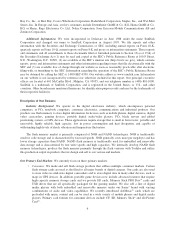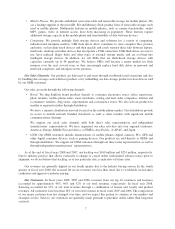SanDisk 2008 Annual Report Download - page 19
Download and view the complete annual report
Please find page 19 of the 2008 SanDisk annual report below. You can navigate through the pages in the report by either clicking on the pages listed below, or by using the keyword search tool below to find specific information within the annual report.
protection, any of which would negatively impact our business, financial condition and results of operations. A
significant portion of our sales are made through retailers, either directly or through distributors. Sales through
these channels typically include rights to return unsold inventory and protection against price declines, as well as
participation in various cooperative marketing programs. As a result, we do not recognize revenue until after the
product has been sold through to the end user, in the case of sales to retailers, or to our distributors’ customers, in
the case of sales to distributors. Price protection against declines in our selling prices has the effect of reducing
our deferred revenues and eventually, our revenues. If our retailers and distributors are not successful, due to
weak consumer retail demand caused by the current worldwide economic downturn, decline in consumer
confidence, or other factors, we could continue to experience reduced sales as well as substantial product returns
or price protection claims, which would harm our business, financial condition and results of operations. Except
in limited circumstances, we do not have exclusive relationships with our retailers or distributors, and therefore,
must rely on them to effectively sell our products over those of our competitors. Certain of our retail and
distributor partners are experiencing financial difficulty and prolonged negative economic conditions could cause
liquidity issues for our retail and distributor customers and channels. For example, two of our North American
retail customers, Circuit City, Inc. and Ritz Camera Centers, Inc., recently filed for bankruptcy protection.
Negative changes in customer credit worthiness; the ability of our customers to access credit; or the bankruptcy
or shutdown of any of our significant retail or distribution partners would harm our revenue and our ability to
collect outstanding receivable balances. In addition, we have certain retail customers to which we provide
inventory on a consigned basis, and a bankruptcy or shutdown of these customers could preclude us from taking
possession of our consigned inventory, which could result in inventory or impairment charges.
We may be unable to renew existing licenses, which could reduce our license and royalty revenues. If our
existing licensees do not renew their licenses upon expiration and we are not successful in signing new licensees
in the future, our license revenue, profitability, and cash provided by operating activities would be harmed. Our
current license agreement with Samsung expires in August 2009, and to the extent that we are unable to renew
this agreement under similar terms or at all, our financial results would be adversely impacted by the reduced
license and royalty revenue and the significant patent litigation costs to enforce our patents against and renew our
license agreement with Samsung. In addition, we may be subject to disputes, claims or other disagreements on
the timing, amount or collection of royalties from Samsung as the current agreement nears expiration.
We may be unable to complete the transactions with Toshiba, announced on January 29, 2009, in a timely
manner, or at all. On January 29, 2009, we entered into a definitive agreement with Toshiba to restructure Flash
Ventures by selling to Toshiba more than 20% of Flash Ventures current production capacity through the
acquisition by Toshiba of certain owned and leased equipment. The total value of the restructuring transaction to
us is approximately $890 million based upon the exchange rate as of January 29, 2009. Approximately one-third
of this value will be in cash paid to us and approximately two-thirds of this value represents a transfer of lease
obligations to Toshiba which should reduce our outstanding lease obligations and associated lease guarantees by
approximately 28%. These transactions are expected to occur at several closings between January 30, 2009 and
March 31, 2009, subject to certain closing conditions and contingencies. However, if we fail to complete the
transactions with Toshiba on a timely basis, or at all, we may continue to experience significant excess captive
capacity and the associated fixed costs, and we would not benefit from the expected cash and reduction in lease
obligations. This would harm our business, financial condition and results of operations.
Our financial performance depends significantly on worldwide economic conditions and the related impact
on levels of consumer spending, which has recently deteriorated significantly in many countries and regions,
including the U.S., and may remain depressed for the foreseeable future. Demand for our products is adversely
affected by negative macroeconomic factors affecting consumer spending. The severe tightening of consumer
credit, low level of consumer liquidity, and extreme volatility in credit and equity markets have weakened
consumer confidence and decreased consumer spending. These and other economic factors have reduced demand
for our products and harmed our business, financial condition and results of operations, and to the extent such
economic conditions continue, they could cause further harm to our business, financial condition and results of
operations.
15
























